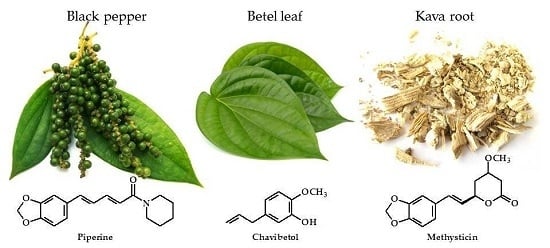Piper Species: A Comprehensive Review on Their Phytochemistry, Biological Activities and Applications
Abstract
Share and Cite
Salehi, B.; Zakaria, Z.A.; Gyawali, R.; Ibrahim, S.A.; Rajkovic, J.; Shinwari, Z.K.; Khan, T.; Sharifi-Rad, J.; Ozleyen, A.; Turkdonmez, E.; et al. Piper Species: A Comprehensive Review on Their Phytochemistry, Biological Activities and Applications. Molecules 2019, 24, 1364. https://doi.org/10.3390/molecules24071364
Salehi B, Zakaria ZA, Gyawali R, Ibrahim SA, Rajkovic J, Shinwari ZK, Khan T, Sharifi-Rad J, Ozleyen A, Turkdonmez E, et al. Piper Species: A Comprehensive Review on Their Phytochemistry, Biological Activities and Applications. Molecules. 2019; 24(7):1364. https://doi.org/10.3390/molecules24071364
Chicago/Turabian StyleSalehi, Bahare, Zainul Amiruddin Zakaria, Rabin Gyawali, Salam A. Ibrahim, Jovana Rajkovic, Zabta Khan Shinwari, Tariq Khan, Javad Sharifi-Rad, Adem Ozleyen, Elif Turkdonmez, and et al. 2019. "Piper Species: A Comprehensive Review on Their Phytochemistry, Biological Activities and Applications" Molecules 24, no. 7: 1364. https://doi.org/10.3390/molecules24071364
APA StyleSalehi, B., Zakaria, Z. A., Gyawali, R., Ibrahim, S. A., Rajkovic, J., Shinwari, Z. K., Khan, T., Sharifi-Rad, J., Ozleyen, A., Turkdonmez, E., Valussi, M., Tumer, T. B., Monzote Fidalgo, L., Martorell, M., & Setzer, W. N. (2019). Piper Species: A Comprehensive Review on Their Phytochemistry, Biological Activities and Applications. Molecules, 24(7), 1364. https://doi.org/10.3390/molecules24071364









